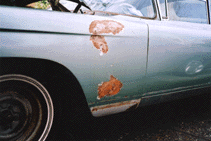 |
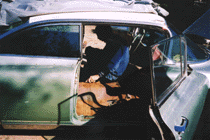 |
and not only did the body need major work, and the mechanical
side of things taken care of as well, the interior needed
to be completely gutted (see photo above right).
|
Larry: When the car arrived in California, it was a basket case. The engine had not been running in probably 25 years. Unfortunately, they started the car to put it on the enclosed trailer when it was transported to California from Nashville. As you can tell by some of the photos, the engine oil had turned to sludge. They did not use detergent oil in those days. In the old days to repair damage to the body, they used to drill holes and pull out the dents. They don't do this anymore. They weld cleats then pull out the dent and sand off the metal cleat. There were only two body parts on the car that had the original paint - the driver's door and the trunk lid. The right rear panel had five different coats of paint from five separate accidents. The left rear panel had four different coats of paint. The right front fender was hit so many times we couldn't count them. It would have been easier to replace the fender, but I had a strong desire to keep all of the parts original. In the old days when they used the hole drilling method, after a period of time the weather would get inside the holes and cause the Bondo body filler to loosen, then the paint would start falling off. Every mechanical part on the car was rebuilt. I have the original factory build order from General Motors on the car. Again, it would have been cheaper and easier to have purchased a rebuilt generator, water pump, distributor, etc., but I wanted to keep all the numbers matching so I had every component that was original to the car rebuilt to factory specifications. On the interior, I was able to find an original bolt of green leather. Even if I had found original interior cloth, after 40 years it would have been rotten and wouldn't have held a stitch. I had to have a factory make a run of cloth to exactly match the original material. Parts were sent all over the country to be rebuilt. The air conditioning went to Tampa, Florida. The interior was done by Jenkins Interior, one of the top Cadillac restorers in the United States. The entire interior was crated and sent to their factory in Wilmington, NC. The speedometer had to be rebuilt and ended up somewhere in Virginia. I remember the water pump ended up in New Jersey to be rebuilt. I know many of the parts ended up in Texas. The list goes on and on. The body work was done by Simpkins Auto Body in Benecia, California. The vinyl roof was put on by Baker Interior in Fairfield, California. The man who was responsible for the entire restoration project is Dean Scott and he lives in Alamo, California. The car has original General Tires that were on the car at the time that Jim Reeves purchased it. There is a company called Cocker Tire Company in Chattanooga, TN. In their business, they buy up old tire molds from companies who go out of business such as General Tire. They are then able to make you the exact tire with all the markings from the original General Tire molds. So the tires came from Chattanooga, TN. The original acid spitting Delco battery came out of Kansas. They make the original Delco acid spitting batteries for the car hobby. Every time we drive the car we have to put a layer of terry cloth towels over the battery to prevent the acid from eating up parts of the engine compartment. As mentioned above, I have the original build order from the factory as well as all the original invoices from the Atlanta Motor Car Company in Atlanta, GA where Jim bought the car. The dealership is now in its third generation of family ownership. During many conversations with the current patriarch, who is well in his eighties, he advised that he was the sales manager of the dealership when Jim Reeves purchased the car. He remembers it well and remarked that they had a salesman on staff by the name of Jim Reeves! He said the salesman could not wait until he had an opportunity to meet his hero and namesake, Jim Reeves. As you might appreciate, some people snicker when I say I spent $135,000 rebuilding the car. I learned the hard way that if you are going to rebuild any car 30 years old or more to factory showroom, Concours condition, it's impossible to do it under $100,000. You can have a car painted with new interior but it will not be to factory specs unless you are willing to spend the money. I'll give you an example. A $29.00 distributor cap ending up costing almost $400. The Eldorado engine is unique and has a special distributor cap not found on any other model not equipped with the Eldorado engine. I looked for a new one for about six months and when I finally found it somewhere up in Maine, sitting on a guy's shelf, he knew he had me and if I wanted it bad enough, I'd pay him. I truly believe I bought the last brand new Eldorado distributor cap in the continental limits of the United States of America. A final problem and one of the biggest, was the vinyl trunk material. I ended up purchasing 10 yards of material on six separate occasions and paying to have it sent to Wilmington to NC so that it could be cut to the specifications of the car. Six times in a row, Hill Jenkins of Jenkins Interior, phoned me and said that when he rolled it out, the inside had turned yellow. I clearly remember that only two of the six people that I purchased this material from gave me a refund. The seventh time I found the material, over a period of about nine months, and had it shipped directly to North Carolina, I finally received the welcome phone call that he was able to get 10 yards of original trunk material that he could use. The car was judged a maximum of 100 points out of 100 points at the final two major Concours last summer. It had won many other first place honors prior to that but not judged 100 points because work was still in progress. I have been advised that it is truly the finest representation of a Cadillac from that era when the name Cadillac truly was the standard of the world. Unfortunately, the car is now an albatross. It is too vulnerable to take it out to any more car shows. I say that from experience. On two occasions last year, the paint was damaged while the car was on display. Once it happened in a car club where I belonged and once at a major Concours when a woman got too close to the car and scratched it with a ring. This resulted in two separate trips back to the body shop. So now the car is safely stored with a cover on it. The car is unique in one additional perspective. Even though it is only 40 years old, the junk yards are void of parts. The reason being no-one restores a two door hardtop to Concours condition. The ones remaining have been cannibalized so the parts can be used on convertibles. 1960 was one of Cadillac's biggest years making over 150,000 cars but only 1,075 of the Eldorado were made. You could buy an entry level Cadillac for a little over $5,000. The Jim Reeves Eldorado with the equipment as delivered brought the selling price up to almost $8,000. Limited production of the Eldorado made it truly the standard of the world in 1960. The car was the last of the big cars. It is 225" in length and weighs in a whopping 4,855 lbs. 1960 was the last year Cadillac put a bigger engine in the Eldorado. It has three Rochester dual barrel carburetors on a 390 cubic inch engine, developing 345 horsepower at 4,800 r.p.m. The car will go from 0 to 60 miles an hour in 10.3 seconds which is even good by today's standard and the cars are much lighter in weight. The car speced out at 14 m.p.g. at 60 miles an hour. Gas mileage is around nine m.p.g. in normal traffic. The Cadillac, even without the Jim Reeves name attached to it, has tremendous historical presence and significance. It is truly the last of a breed and one of only a few left in the world of this model. As I continuously preach to Carthage, 50 years from now, people will travel a significant distance just to see the car. But if you put it together with one of the greatest bass baritones in the world, sprinkled with one of the largest record collections on an individual artist, personal memorabilia too vast to list, and all of the original equipment from an old radio station, you suddenly have one very interesting museum with major drawing power and historical significance. I will close this by saying that even if one
doesn't like the music of Jim Reeves, the Cadillac with all of
the related Jim Reeves memorabilia in my possession, including
acetates, radio transcriptions, magazine covers, approx. 500
mounted and framed artifacts, it would be a most interesting
place to visit. It was very fortunate that Jim Reeves was on
RCA, for the records in my collection were pressed around the
world from Dum Dum, India to Yugoslavia. Just imagine a young
person walking around the continents of the world seeing recordings
from Jim Reeves on display. Let's not forget that the telegram
is from a bygone era and most young people have never even seen
one. This type of an educational display would draw crowds no
matter where it ended up. But as you have heard me say over the
years, the only place it has any chance for long term survival
is the city of Carthage where they truly have a vested Larry, as you know better than anyone, I have never promised anybody anything. I have maintained for years that I would like to see all of this on display. You have also heard me say for many years, that I have never been concerned about what would happen to my collection in my lifetime. I am concerned about where it will be 75 to 100 years from now. Just imagine if I don't take the time to do this correctly, what would prevent a city manager 75 years from now selling the Cadillac to build a new water treatment plant! It is one thing to want something, and quite another story to accomplish your goal. I am pleased to share the pictures of the car and a little of its history with the world wide fans of Jim Reeves. Respectfully James Newberry |
|
|
 |
 |
 |
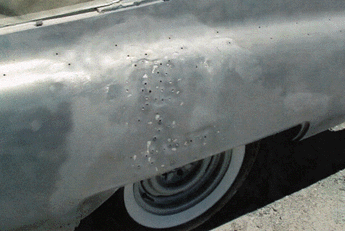 |
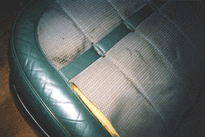 |
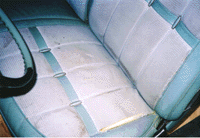 |
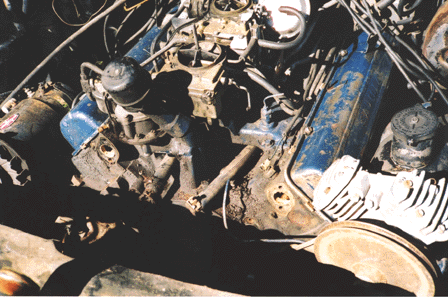 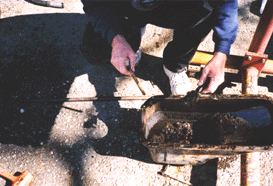 |